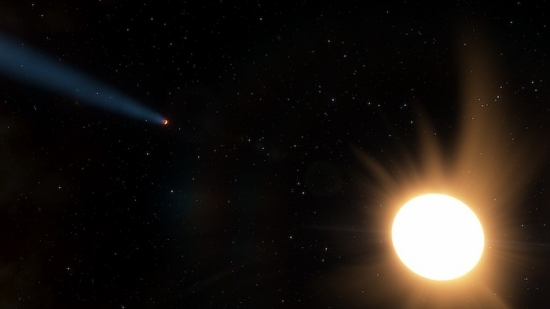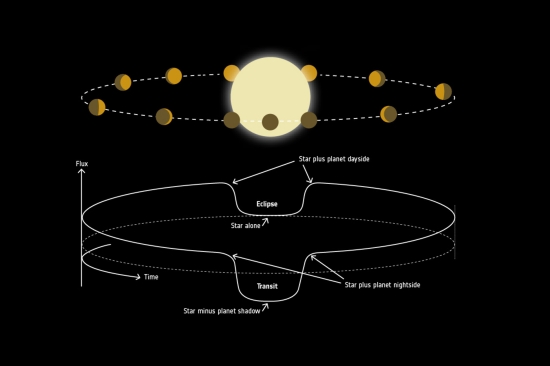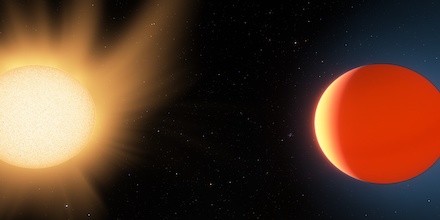Scientists have created the first global temperature map for a planet discovered by TESS, a ‘hot Neptune’ known as LTT 9779b. The first of two just released papers also notes that this is the first spectral atmospheric characterization of a TESS planet. That makes this unusual discovery (lead author Ian Crossfield calls it a “planet that shouldn’t exist”) a useful test case for future work, because the goal of finding the biosignatures of living worlds won’t be achieved without drilling down from inhospitable places like LTT 9779b. The atmospheres of hotter, larger and more readily characterizable planets let us hone our techniques and teach us how to proceed.
Crossfield’s reference to the planet’s rarity draws on the fact that so few worlds like this occur close to their host stars, probably because their mass is low enough that the proximity to the star causes atmospheric evaporation. A larger gas giant like one of the ‘hot Jupiters’ we began finding in the beginning of the exoplanet hunt can hang on to an atmosphere in breathtaking proximity to its star, but a smaller world might lose its gases and become an airless rocky place.

In an email yesterday, Dr. Crossfield (University of Kansas) put his work on this world in context:
What surprised us the most about LTT9779b is that this planet’s atmosphere seems quite different from those of bigger gas giants. A main theory nowadays is that for transiting planets, temperature is the single most important factor in determining the composition & structure of a planet’s atmosphere. But although our hot Neptune is the same temperature as many of the big “hot Jupiters” that have been studied before, its atmosphere looks quite different. LTT 9779b is the first really hot Neptune with a measured atmospheric spectrum and phase curve. We hope it will be the prototype for studying these kinds of objects with the upcoming James Webb Space Telescope. But if there’s one thing we’ve learned, it’s that new exoplanets always find ways to surprise us.

Image: This artist’s impression shows the LTT 9779 system approximately to scale, with the hot Neptune-sized planet at left and its bright, nearby star at right. The trail of material streaming off of the planet is hypothetical but likely, based on the intense irradiation of this planet. Credit: Ethen Schmidt | University of Kansas.
So what does LTT 9779b have to teach us? Crossfield and colleagues show us a planet so close to its star that it reaches temperatures in the range of 1650?. Working with Spitzer data, the team used phase curve analysis to learn about the atmosphere. The object’s phase curve describes its brightness in relation to its phase angle, with the scientists measuring infrared light as the planet rotated 360 degrees on its axis. In a KU news release, Crossfield added:
“Infrared light tells you the temperature of something and where the hotter and cooler parts of this planet are — on Earth, it’s not hottest at noon; it’s hottest a couple of hours into the afternoon. But on this planet, it’s actually hottest just about at noon. We see most of the infrared light coming from the part of the planet when its star is straight overhead and a lot less from other parts of the planet.”
A bit more on this method: The fraction of light reflected off a transiting planet changes during its orbit depending on the planet’s position with regard to the star, as shown in the image below. Untangling this information gives us a way to examine heat transport from the day side to the night side. Phase curve analysis can be used to infer the presence of clouds and even to extract data on their composition. Such analysis has been performed for hot Jupiters, but as the Crossfield et al. paper points out, the work on LTT 9779b takes us into new territory, for “no infrared phase curve data exist for any similar planet (i..e, within a factor of three of LTT 9779b’s mass and a factor of two of its temperature).”

Image: The phase curve method to study extrasolar planets. Depending on a planet’s position with respect to its host star, the total light collected by a telescope will include a varying fraction of light reflected off the planet, in a similar manner to how we experience the phases of the Moon. The planet reflects no light during a phase known as secondary eclipse, when it is hidden from view, whereas it reflects some light shortly before and after this phase. In addition to that, the planet blocks a fraction of the light as it transits in front of the star. Credit: ESA.
Lead would melt in the atmosphere of LTT 9779b, and so, as Crossfield notes, would platinum, chromium and stainless steel in an environment where the day is less than 24 hours long. Co-author Nicolas Cowan (Institute for Research on Exoplanets and McGill University) was involved in the interpretation of the thermal phase curve measurements:
“The planet is much cooler than we expected, which suggests that it is reflecting away much of the incident starlight that hits it, presumably due to dayside clouds. The planet also doesn’t transport much heat to its nightside, but we think we understand that: The starlight that is absorbed is likely absorbed high in the atmosphere, from whence the energy is quickly radiated back to space.”
The data show spectral absorption features indicating carbon monoxide and/or carbon dioxide. This information, along with the global temperature map that emerges from the phase curve data, allows deductions about atmospheric circulation. A second paper on the planet investigates the atmosphere through secondary eclipse observations. The lead author of the second paper is Diana Dragomir (University of New Mexico), with Crossfield as co-author (citations below).

Image: This artist’s impression shows LTT 9779b near the star it orbits, and highlights the planet’s ultra-hot (2000 Kelvin) day-side and its quite-toasty night-side (around 1000 K). Credit: Ethen Schmidt | University of Kansas.
With the primary two-year TESS mission close to completion, we will wind up with 85 percent of the sky surveyed for planets transiting nearby stars. LTT 9779b stands out among the planets thus far surveyed, as the Crossfield et al. paper notes in its conclusion:
LTT 9779b remains one of the best targets of its type – i.e., among highly irradiated hot Neptunes that are highly favorable for thermal emission measurements – and so it is likely to remain one of the most easily-characterizable exoplanets in its class. Future phase curve and eclipse observations of LTT 9779b and other similar planets will provide the impetus for the next generation of global circulation modeling of Neptune-size planets, supporting similar observations of many such objects with JWST, ARIEL, and future observatories.
There is much to probe here, including firming up why comparatively little heat is transported to the night side from the hellish day. The strength of the signal here is a key advantage, making the world an excellent shake-out of the techniques we’ll one day use to probe the atmospheres of smaller worlds in search of biosignatures.
The paper is Crossfield et al., “Phase Curves of Hot Neptune LTT 9779b Suggest a High-metallicity Atmosphere,” Astrophysical Journal Letters Vol. 903, No. 1 (26 October 2020). Abstract available. The Dragomir et al. paper is “Spitzer Reveals Evidence of Molecular Absorption in the Atmosphere of the Hot Neptune LTT 9779b,” Astrophysical Journal Letters Vol. 903, No. 1 (26 October 2020). Abstract.



Thanks for your interest! For anyone wanting to read in more detail, free access to the papers is available here
https://arxiv.org/pdf/2010.12745.pdf
and here
https://arxiv.org/pdf/2010.12744.pdf
Thank you Ian. Can phase curve analysis be used to determine if there are rings around a planet?
Dear Kamal — “yes” in principle. But in practice the first, more straightforward test would be to carefully examine the transit light curve shape made by a ringed planet as it crosses in front of its host star. One study that looked into this more is here: https://arxiv.org/abs/1502.07818
In the first paper ( https://arxiv.org/pdf/2010.12745.pdf ) they say the planet has an irradiation temperature of 2770 K, an equilibrium temperature of 1960, and an observed nightside temperature of 700 +- 430 K. Yes, it’s a hot Neptune with a thick atmosphere nearly an order of magnitude away from the habitable zone but that doesn’t rule out that they could have a white Christmas!
The idea that the starlight is absorbed high in the atmosphere makes sense. Carbon dioxide and Carbon monoxide are efficient absorbers of black body thermal infra red radiation, so the atmosphere of LTT 9779b is a black body radiator at the top of the atmosphere and gets cooler towards the surface.
The albedo is probably high with a Neptune sized ice giant with clouds of water vapor which reflects the light away and keeps the bottom of the atmosphere cooler if we include a layer of CO2/CO which is only at the top of the atmosphere which absorbs the heat and re radiates it away into space in the form of thermal infra red as a black body radiator. The clouds absorb some of the infra red radiated towards the surface.
Maybe the CO2/CO forms from some photo dissociation of Methane CH4, and water H2O and recombines to make the CO2/CO? Both Uranus and Neptune have mantles of H2O, NH3 and CH4. Maybe some of that has evaporated into the atmosphere on LTT 9779b or it never was frozen, so there is different chemistry in LTT 9779b’s atmosphere than our ice giants. One thing is fore sure is that carbon monoxide breaks it’s molecular bond only at a high temperature, so maybe it is a gas which will hang around in LTT 9779b atmosphere for a long time.
Geoffrey — most of your description above looks spot-on to me. Regarding the source of the CO or CO2, though, these likely didn’t form from photo-dissociation of methane (CH4). Instead, at these very high temperatures (>2000 K) the equilibrium products of C, O, and H atoms are mostly CO and H2O, with a bit of CO2 as well. In the much colder atmospheres of Jupiter or Saturn, the equilibrium products formed are CH4. So it’s more a temperature effect than a photodissociation effect.
I left out the potential for the tops of clouds or the cloud layer to reflect infra red radiation back into CO layer and top of atmosphere where it would be re absorbed and then re radiated back into space which would also help keep the day side and top of the atmosphere a lot hotter compared to the night side.